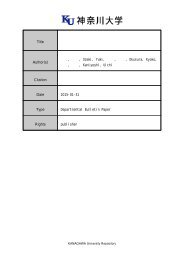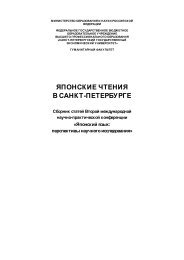to Learners with Special Educational Needs
e-textbook SEN
e-textbook SEN
You also want an ePaper? Increase the reach of your titles
YUMPU automatically turns print PDFs into web optimized ePapers that Google loves.
Pokrivčáková, S. et al. (2015). Teaching Foreign Languages <strong>to</strong> <strong>Learners</strong> <strong>with</strong> <strong>Special</strong> <strong>Educational</strong> <strong>Needs</strong>:<br />
e-textbook for foreign language teachers. Nitra: Constantine the Philosopher University. 128 p.<br />
ISBN 978-80-558-0941-0<br />
5 Teaching English as a foreign language<br />
<strong>to</strong> learners <strong>with</strong> ADD and ADHD<br />
Mária Babocká<br />
DOI: 10.17846/SEN.2015.81-90<br />
Objectives of the chapter<br />
<strong>to</strong> define the basic terms connected <strong>to</strong> EFL teaching of ADD and ADHD learners;<br />
<strong>to</strong> explain the differences between ADD and ADHD learners;<br />
<strong>to</strong> provide a basic framework for classroom management which can help teachers working<br />
<strong>with</strong> ADD and ADHD learners;<br />
<strong>to</strong> provide some practical examples and activities suitable for learners <strong>with</strong> these disorders.<br />
Terminology and literature review<br />
Primary and secondary EFL teachers are often called upon <strong>to</strong> work <strong>with</strong> mixed-ability groups.<br />
Nowadays, more and more often, inclusive education means that differences between learners<br />
are very large, as learners <strong>with</strong> special education needs are integrated in<strong>to</strong> EFL classes. From a<br />
teacher’s viewpoint, it can then become difficult <strong>to</strong> manage the classroom <strong>to</strong> ensure the progress<br />
of different kinds of learners. The crucial questions are as follows:<br />
- How <strong>to</strong> teach and manage both kinds of learners (<strong>with</strong> and <strong>with</strong>out special education needs)<br />
in order <strong>to</strong> achieve education objectives?<br />
- How <strong>to</strong> manage both kinds of learners so that all the students can experience their own<br />
learning progress?<br />
In this chapter, we will focus on two education disorders: ADD and ADHD.<br />
ADHD is the acronym for Attention-Deficit Hyperactivity Disorder. As the name suggests, the<br />
condition entails inattention, hyperactivity and impulsivity. ADD means Attention-Deficit<br />
Disorder. At first glance children <strong>with</strong> this syndrome are not hyperactive, but only have<br />
problems <strong>with</strong> concentration. However, as Anderson (2015) states, this was never the intended<br />
application of the term; in fact, it was used <strong>to</strong> describe the same disorder until 1987: “Before<br />
that, say in 1980, a child would be diagnosed <strong>with</strong> ADD, either <strong>with</strong> or <strong>with</strong>out hyperactivity. But<br />
starting in the early 1990s, that child would be diagnosed <strong>with</strong> ADHD.” In this chapter, we will<br />
mainly use the term “ADHD learners.”<br />
We differentiate three general types of ADHD learners:<br />
Inattentive: These children have problems <strong>with</strong> concentration. In the EFL classroom, they<br />
have difficulties in sustaining attention when working on some education tasks, listening <strong>to</strong><br />
the teacher’s instructions, or completing tests. They are easily distracted and very sensitive <strong>to</strong><br />
all visual and aural stimuli, which often causes problems <strong>with</strong> self-regulation.<br />
Hyperactive/Impulsive: The symp<strong>to</strong>ms of hyperactivity can be defined as “commonly<br />
occurring, minor mo<strong>to</strong>r activities that are performed at abnormally high intensity and high<br />
frequency levels” (Hughes, Cooper, 2007, p. 4). In other words, these children are extremely<br />
restless and can be a handful for teachers – they tend <strong>to</strong> constantly walk around, jump, climb,<br />
talk, tap their fingers, or stamp their feet. Meanwhile, impulsive children are impatient; in the<br />
classroom, when they know a correct answer they just blurt it out, ignoring the teacher’s<br />
instructions. They also have problems in waiting their turn in games, activities, discussions<br />
and conversations. This can cause a lot of problems, particularly in EFL lessons, where the<br />
practice and production of new language are realized through communicative group work,<br />
pair work, cooperation, and problem-solving activities. In these cases, improper management<br />
of collective activities can negatively affect both the ADHD learner and his/her classmates.<br />
Combined: These children show all three symp<strong>to</strong>ms – inattention, impulsivity and<br />
hyperactivity – in their classroom behaviour (Hughes, Cooper, 2007).<br />
81






